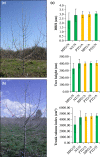RNA interference suppression of AGAMOUS and SEEDSTICK alters floral organ identity and impairs floral organ determinacy, ovule differentiation, and seed-hair development in Populus
- PMID: 30565259
- PMCID: PMC6590139
- DOI: 10.1111/nph.15648
RNA interference suppression of AGAMOUS and SEEDSTICK alters floral organ identity and impairs floral organ determinacy, ovule differentiation, and seed-hair development in Populus
Abstract
The role of the floral homeotic gene AGAMOUS (AG) and its close homologues in development of anemophilous, unisexual catkins has not previously been studied. We transformed two RNA interference (RNAi) constructs, PTG and its matrix-attachment-region flanked version MPG, into the early-flowering female poplar clone 6K10 (Populus alba) to suppress the expression of its two duplicate AG orthologues. By early 2018, six out of 22 flowering PTG events and 11 out of 12 flowering MPG events showed modified floral phenotypes in a field trial in Oregon, USA. Flowers in catkins from modified events had 'carpel-inside-carpel' phenotypes. Complete disruption of seed production was observed in seven events, and sterile anther-like organs in 10 events. Events with strong co-suppression of both the two AG and two SEEDSTICK (STK) paralogues lacked both seeds and associated seed hairs. Alterations in all of the modified floral phenotypes were stable over 4 yr of study. Trees from floral-modified events did not differ significantly (P < 0.05) from nonmodified transgenic or nontransgenic controls in biomass growth or leaf morphology. AG and STK genes show strong conservation of gene function during poplar catkin development and are promising targets for genetic containment of exotic or genetically engineered trees.
Keywords: AGAMOUS; SEEDSTICK; Populus; RNAi; containment; flowering; matrix attachment region; sterility.
© 2018 The Authors. New Phytologist © 2018 New Phytologist Trust.
Figures







Similar articles
-
Repression of gibberellin biosynthesis or signaling produces striking alterations in poplar growth, morphology, and flowering.Planta. 2011 Dec;234(6):1285-98. doi: 10.1007/s00425-011-1485-x. Epub 2011 Jul 27. Planta. 2011. PMID: 21792553
-
Separation of AG function in floral meristem determinacy from that in reproductive organ identity by expressing antisense AG RNA.Plant Mol Biol. 1995 Aug;28(5):767-84. doi: 10.1007/BF00042064. Plant Mol Biol. 1995. PMID: 7640351
-
Populus CEN/TFL1 regulates first onset of flowering, axillary meristem identity and dormancy release in Populus.Plant J. 2010 May 1;62(4):674-88. doi: 10.1111/j.1365-313X.2010.04185.x. Epub 2010 Feb 26. Plant J. 2010. PMID: 20202169
-
Variation in floral form of CRISPR knock-outs of the poplar homologs of LEAFY and AGAMOUS after FT heat-induced early flowering.Hortic Res. 2023 Jun 29;10(8):uhad132. doi: 10.1093/hr/uhad132. eCollection 2023 Aug. Hortic Res. 2023. PMID: 37564267 Free PMC article.
-
Revisiting tree maturation and floral initiation in the poplar functional genomics era.New Phytol. 2004 Oct;164(1):43-51. doi: 10.1111/j.1469-8137.2004.01165.x. New Phytol. 2004. PMID: 33873486 Review.
Cited by
-
Silencing of GhSHP1 hindered flowering and boll cracking in upland cotton.Front Plant Sci. 2025 Feb 25;16:1558293. doi: 10.3389/fpls.2025.1558293. eCollection 2025. Front Plant Sci. 2025. PMID: 40070717 Free PMC article.
-
Identification of autophagy-related genes ATG18 subfamily genes in potato (Solanum tuberosum L.) and the role of StATG18a gene in heat stress.Front Plant Sci. 2024 Aug 27;15:1439972. doi: 10.3389/fpls.2024.1439972. eCollection 2024. Front Plant Sci. 2024. PMID: 39263419 Free PMC article.
-
Mobility of FLOWERING LOCUS T protein as a systemic signal in trifoliate orange and its low accumulation in grafted juvenile scions.Hortic Res. 2022 Mar 7;9:uhac056. doi: 10.1093/hr/uhac056. eCollection 2022. Hortic Res. 2022. PMID: 35702366 Free PMC article.
-
RNAi of AGAMOUS genes in sweetgum alters reproductive organ identity and decreases fruit persistence.Plant Direct. 2020 May 21;4(5):e00225. doi: 10.1002/pld3.225. eCollection 2020 May. Plant Direct. 2020. PMID: 32490346 Free PMC article.
-
Characterization of Phytohormones and Transcriptomic Profiling of the Female and Male Inflorescence Development in Manchurian Walnut (Juglans mandshurica Maxim.).Int J Mol Sci. 2022 May 13;23(10):5433. doi: 10.3390/ijms23105433. Int J Mol Sci. 2022. PMID: 35628244 Free PMC article.
References
-
- Abranches R, Shultz RW, Thompson WF, Allen GC. 2005. Matrix attachment regions and regulated transcription increase and stabilize transgene expression. Plant Biotechnology Journal 3: 535–543. - PubMed
-
- Allen GC, Spiker S, Thompson WF. 2000. Use of matrix attachment regions (MARs) to minimize transgene silencing. Plant Molecular Biology 43: 361–376. - PubMed
-
- Bennett EJ, Roberts JA, Wagstaff C. 2011. The role of the pod in seed development: strategies for manipulating yield. New Phytologist 190: 838–853. - PubMed
-
- Bowman JL, Smyth DR, Meyerowitz EM. 1991. Genetic interactions among floral homeotic genes of Arabidopsis . Development 112: 1–20. - PubMed
Publication types
MeSH terms
Substances
Associated data
- Actions
- Actions
Grants and funding
- 2010-33522-21736/USDA Biotechnology Risk Assessment Research Grants Program/International
- 2011-68005-30407/USDA Biotechnology Risk Assessment Research Grants Program/International
- OREZ-FS-671-R/USDA-IFAS/International
- TBGRC industrial cooperative at Oregon State University/International
- 0736283/National Science Foundation I/UCRC Center for Advanced Forestry/International
LinkOut - more resources
Full Text Sources
Miscellaneous

